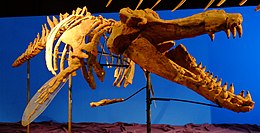Brygmophyseter
| Brygmophyseter | |
|---|---|

| |
| Restored skeleton | |
| Scientific classification | |
| Domain: | Eukaryota |
| Kingdom: | Animalia |
| Phylum: | Chordata |
| Class: | Mammalia |
| Order: | Artiodactyla |
| Infraorder: | Cetacea |
| Superfamily: | Physeteroidea |
| Family: | incertae sedis |
| Genus: | †Brygmophyseter Barnes, 2006 |
| Species: | †B. shigensis
|
| Binomial name | |
| †Brygmophyseter shigensis (Hirota and Barnes, 1995)
| |
| Synonyms | |
| |
Brygmophyseter, known as the biting sperm whale, is an
History of discovery
The
The genus name is a combination of the Ancient Greek word brygmos, which means "biting" or "gnashing", combined with physeter, which is the generic name of the living sperm whale, and also means "blower" in Ancient Greek.[1][4] The junior synonym Naganocetus derives from the Nagano Prefecture and the Latin cetus meaning "whale".[5]
Description

Like other raptorials, Brygmophyseter had enamel-coated teeth in both jaws, unlike the modern

Brygmophyseter is estimated to have been around 6.5–7 meters (21–23 ft) long.
The head of the humerus arm bone of Brygmophyseter was positioned perpendicular to the shaft. The elbow joint on the humerus was not distinct from the ulna, typical in cetaceans. The ulna was more primitive than that of the modern sperm whale, in that the shaft was longer and more slender, and the head of the bone was smaller.[1]
Taxonomy
Phylogeny

Brygmophyseter is a member of a fossil
The species was first described in 1994 by
| ||||||||||||||||||||||||||||||||||||||||||
| Relationships between Brygmophyseter and other sperm whales, raptorials in bold[12][9] |
Paleoecology
Since Brygmophyseter was a raptorial, and the group is characterized by their adaptations for subduing large prey, Brygmophyseter was likely a macropredator of marine mammals and other large marine vertebrates, occupying a niche similar to the killer whale. Though no stomach remains or bite marks have been found, it is thought to have preyed upon a variety of animals, including whales, seals, fish, and cephalopods.[7]
Brygmophyseter was discovered in the
In fiction
Brygmophyseter was featured in the fifth episode of
See also
References
- ^ a b c d e f g h i Kimura, T.; Hasegawa, Y.; Barnese, L. G. (2006). "Fossil sperm whales (Cetacea, Physeteridae) from Gunma and Ibaraki prefectures, Japan; with observations on the Miocene fossil sperm whale Scaldicetus shigensis Hirota and Barnes, 1995". Bulletin of the Gunma Museum of Natural History. 103: 1–23.
- ^ "Shigamakkoukujira (Scaldicetus shigensis)". Archived from the original on 1 February 2009.
- ^ "Brygmophyseter Shignesis in Shiga Fossil Museum, Japan". Archived from the original on 9 February 2009.
- ^ "Research & Collection News" (PDF). Paleontology. Natural History Museum of Los Angeles County. May 2006. Archived from the original (PDF) on 30 September 2007. Retrieved 29 April 2010.
- ^ .
- ^ .
- ^ S2CID 14542690.
- S2CID 239510338.
- ^ hdl:11568/814760.
- ^ Toscano, A.; Abad, M.; Ruiz, F.; Muñiz, F.; Álvarez, G.; García, E.; Caro, J. A. (2013). "Nuevos Restos de Scaldicetus (Cetacea, Odontoceti, Physeteridae) del Mioceno Superior, Sector Occidental de la Cuenca del Guadalquivir (Sur de España)" [New Remains of Scaldicetus (Cetacea, Odontoceti, Physeteridae) from the Upper Miocene, Western Sector of the Guadalquivir Basin]. Revista Mexicana de Ciencias Geológicas (in Spanish). 30 (2).
- S2CID 85723286.
- ISBN 978-1-4214-2326-5.
- ISBN 978-1-118-56155-3.
- .
- .
- ^ Takakuwa, Y.; Koike, H.; Narita, K. (2009). "Outline of fossil elasmobranchs from the Middle Miocene Bessho and Aoki Formations, Nagano Prefecture, Japan". Research Report of the Shinshushinmachi Fossil Museum (in Japanese). 13: 7–18.
- ^ Koike, H.; Ohe, F.; Narita, K. (2008). "A fossil dermal denticle, Scymnodon ichiharai (Elasmobranchii; Somniosidae) from Miocene Bessho Formation in Azumino City, Nagano Prefecture, Japan". Research Report of the Shinshushinmachi Fossil Museum (in Japanese). 11: 1–13.
- ^ Koike, H.; Ohe, F.; Narita, K. (2008). "A fossil dermal denticle, Etmopterus sp. (Elasmobranchii; Etmopteridae) from the Middle Miocene Bessho Formation in Azumino City, Nagano Prefecture, Japan". Research Report of the Shinshushinmachi Fossil Museum (in Japanese). 11: 15–18.
- The History Channel. Retrieved 26 November 2017.
